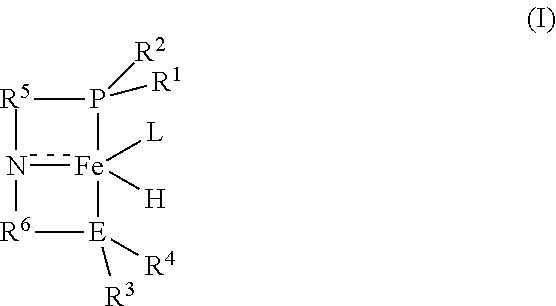Iron-catalyzed cross-coupling of methanol with secondary or tertiary alcohols to produce formate esters
a technology of alkyl formate and methanol, which is applied in the field of organic chemistry, can solve the problems of carbonylation reactions, poor equilibrium constant of methyl formate to form formic acid, and low maximum yield of formic acid from this process
- Summary
- Abstract
- Description
- Claims
- Application Information
AI Technical Summary
Benefits of technology
Problems solved by technology
Method used
Image
Examples
example 5
[0118]Example 3 was repeated, except that methyl methacrylate (8.5 mL, 80 mmol) was also charged to the reactor and the reaction time was increased to 4 hours. The results are reported in Table 2.
[0119]As seen from Table 2, surprisingly, when a mixture of MeOH and CyOH (1:4 molar ratio) was heated to 140° C. in toluene in the presence of excess of methyl methacrylate and 1 mol % of 1A, quantitative conversion of methanol was observed in four hours and the desired cyclohexyl formate was produced with 91% yield. Traces of 2-methylcylohexanone and methyl formate were also detected by GC-MS. Noticeably, no external base, which is often used in large excess in other dehydrogenative processes, was required in this reaction.
example 6
[0120]Example 5 was repeated, except that complex 1B was charged to the reactor instead of 1A. The results are reported in Table 2.
example 7
[0121]Example 5 was repeated, except that complex 1C was charged to the reactor instead of 1A. The results are reported in Table 2.
[0122]As seen from Table 2, complexes 1B and 1C were less effective and afforded <1% and 69% yield of CyOCHO, respectively. It was not surprising to observe a small amount of product formation with 1B under base-free conditions, because it generally requires one equivalent of base to initiate catalysis.
PUM
| Property | Measurement | Unit |
|---|---|---|
| temperature | aaaaa | aaaaa |
| temperatures | aaaaa | aaaaa |
| temperatures | aaaaa | aaaaa |
Abstract
Description
Claims
Application Information
 Login to View More
Login to View More - R&D
- Intellectual Property
- Life Sciences
- Materials
- Tech Scout
- Unparalleled Data Quality
- Higher Quality Content
- 60% Fewer Hallucinations
Browse by: Latest US Patents, China's latest patents, Technical Efficacy Thesaurus, Application Domain, Technology Topic, Popular Technical Reports.
© 2025 PatSnap. All rights reserved.Legal|Privacy policy|Modern Slavery Act Transparency Statement|Sitemap|About US| Contact US: help@patsnap.com



